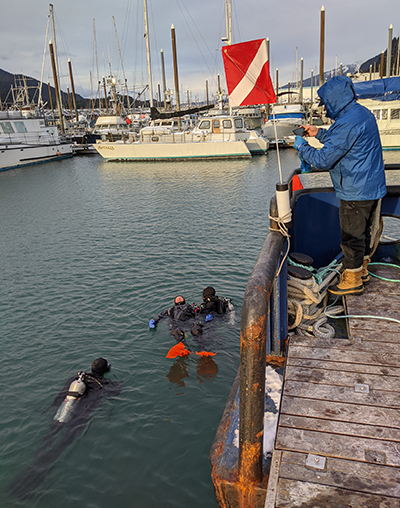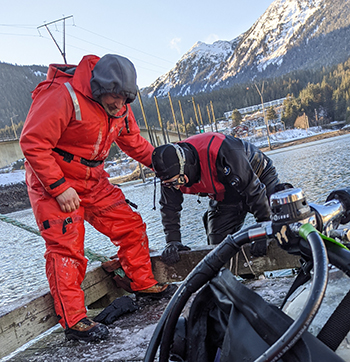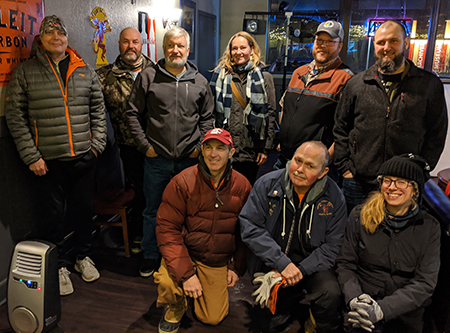Alaska Fish & Wildlife News
March 2020
Diving in the Dead of Winter
Dive Team Learns Ship Husbandry

On three freezing days in mid-January, a half-dozen state divers jumped off the back deck of the state research vessel Medeia for training in Juneau’s Harris Harbor.
Members of the Alaska Department of Fish and Game’s dive team generally spend their time underwater looking at living things like herring spawn, sea cucumbers, geoducks and sea urchins. The mid-winter training provided a new set of skills known as ship husbandry.
“For us, that’s looking at the bottom of the boat, checking stuff out, being the eyes underwater,” said diver Jeff Meucci. Meucci works for Fish and Game’s Commercial Fisheries Division on the research side and serves as the dive master on board the state research vessel Kestrel.
“We’re classified as scientific divers,” he said. “If we get to put our scuba gear on and check out the underwater portion of Medeia or the Kestrel we’re bound by different rules and regulations. We needed to practice a few different scenarios we might see underwater. Sometimes the vessels might have a restriction in a coolant system, or we might hit a piece of floating debris, or check out the propeller to free a line from a crab pot or a net, and we need the training and experience do that safely and effectively.”

Meucci said if the captain or engineer of the vessels suspect something may be amiss underwater, the divers can inspect the underside of the hull or different systems underwater and take pictures for reference.
“If you been aboard a boat for a while, you can tell if something is different underneath, by the sound and feel - the captain and engineer are always checking the systems on the boat,” he said.

The Medeia is home ported in Juneau and the Kestrel is based in Petersburg. Participants in the training are also based in both locations and included divers Kyle Hebert (Juneau), Jeff Meucci (Petersburg), Cedar Stark (Juneau), Jim deLaBruere (Juneau), Katie Taylor (Petersburg) and Adam Messmer (Juneau); top side support included Craig Conger( Juneau), April Rebert (Juneau) and Erik Larson (Petersburg). The instructor was Allen Alloway of Wind and Water Scuba, based in Ketchikan.
The sea water temperature off Juneau averages about 40 degrees F in January.
“When we got out of the water in our dry suits everything froze,” Meucci said. “It got down to single digits that week and the wind was blowing extremely hard, so the wind chill added quite a bit to that cold. It’s not the water that gets us, it’s the ambient air temperature and the wind. Once we’re in the water we’re fine.

There are 22 divers in the dive program in the Southeast Region, that stretches from Yakutat to Ketchikan.
The Southeast dive team starts their dive season in Mid-March with herring work in Sitka Sound and is followed with herring spawn depositions throughout Southeast Alaska through Mid-May. They transition from herring work to dive surveys that include geoduck clams, sea urchins and sea cucumber surveys and occasional abalone work throughout Southeast Alaska.
Subscribe to be notified about new issues
Receive a monthly notice about new issues and articles.
